SHRUBS > FORSYTHIA > VARIETIES
Reviewed By COLIN SKELLY

Colin is a Horticulturist and Horticultural Consultant with experience in a range of practical and managerial roles across heritage, commercial and public horticulture. He holds the Royal Horticultural Society’s Master of Horticulture award and has a particular interest in horticultural ecology and naturalistic planting for habitat and climate resilience.
IN THIS GUIDE
- 1) F. x intermedia ‘Meadowlark’
- 2) F. x intermedia Week End ‘Courtalyn’
- 3) F. x intermedia ‘Lynwood Variety’
- 4) F. ‘Courtasol’
- 5) F. x intermedia ‘Kolgold’
- 6) F. x intermedia ‘Goldrausch’
- 7) F. koreana
- 8) F. ovata ‘Tetragold’
- 9) F. ‘Fiesta’
- 10) F. ‘Show Off Starlet’
- 11) F. suspensa ‘Nymans’
- 12) F. europaea
- 13) F. x intermedia ‘Spectabilis’
- 14) Abeliophyllum distichum
- Variety Origins
- References
FORSYTHIA GUIDES
Container Growing
Pruning
Varieties
Forsythia has quite an interesting distribution.
It has eleven species of which ten are native to Southern and Eastern China, Japan, and the Koreas, and only one is native to Europe, specifically Albania and the Carpathians.1Forsythia viridissima. (n.d.). Kew Royal Botanic Gardens. Retrieved March 16, 2023, from https://powo.science.kew.org/taxon/urn:lsid:ipni.org:names:608903-1
In China they are found growing wild along streams.
Underneath we evaluate fourteen Forsythia varieties – then offer some background on the origins of each.
1) F. x intermedia ‘Meadowlark’
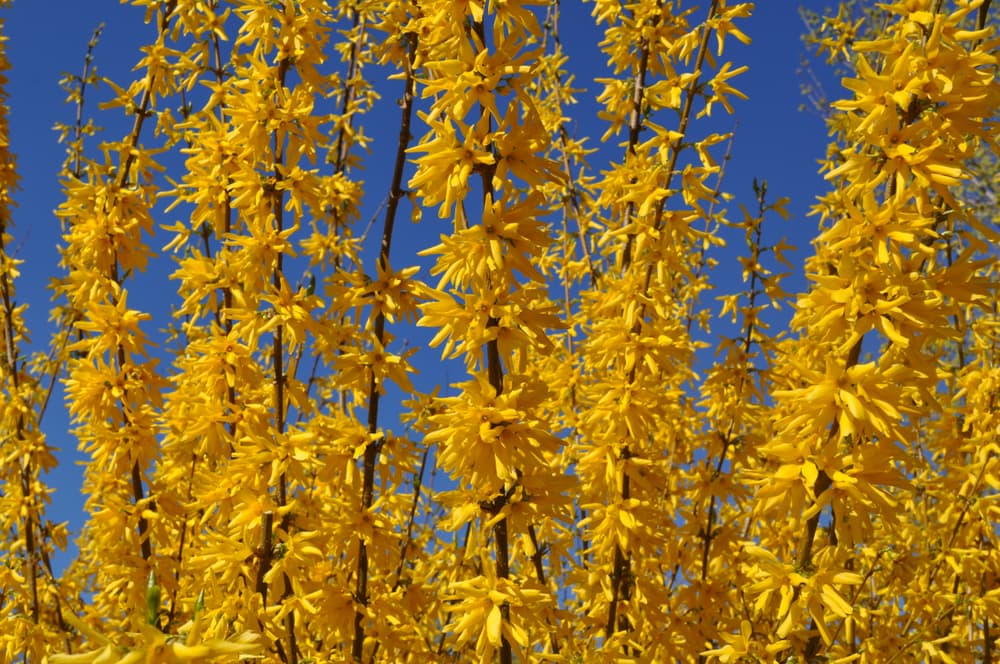
An American cultivar.
Its deep-yellow flowers fall away earlier than many other species but the buds are hardy down to near-freezing.
It is even more pest- and disease-resistant than other Forsythia varieties, and that’s saying something.
It reaches a height just shy of 3m and has about the same spread.
2) F. x intermedia Week End ‘Courtalyn’
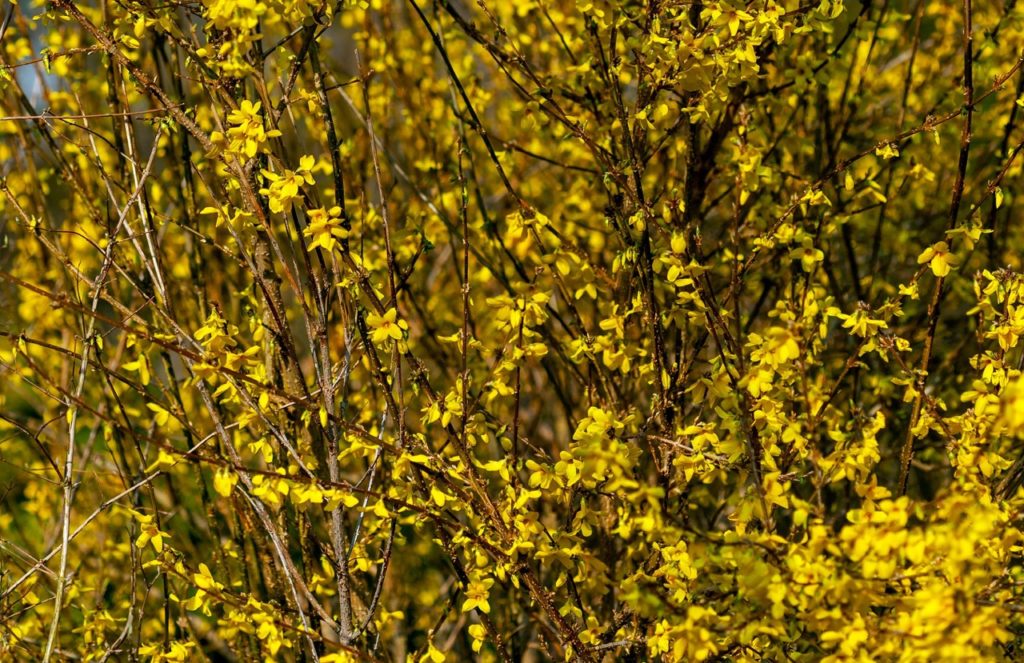
A popular and widely-available variety.
The branches are stiffly erect; reaching a height of right around 2m and a similar spread, it’s a perfect medium-sized shrub.
It has lance-shaped leaves on its slender, erect branches and in spring, each branch is covered with beautiful bright golden blooms that are each around 3cm across.
It blooms profusely through spring.
3) F. x intermedia ‘Lynwood Variety’

“F. x intermedia ‘Lynwood Variety’ is the cultivar that I most often plant and its reliability and large flowers are reflected in its AGM status,” says Colin Skelly, Horticulturist Consultant.
“I typically use these at the back of mixed borders, but some of the smaller cultivars present the opportunity to use them in new ways. It’s always a school day in the garden!”
This variety of forsythia is also a moderately large shrub, growing up to 2.5m in height and width.
Another popular and widely-available variety.
Its branches too are stiffly upright.

It reaches a height of 2-3m while the flowers are closer to 4cm.
It is a profuse bloomer and is recognised for its vigour with the RHS’s Award of Garden Merit.
4) F. ‘Courtasol’
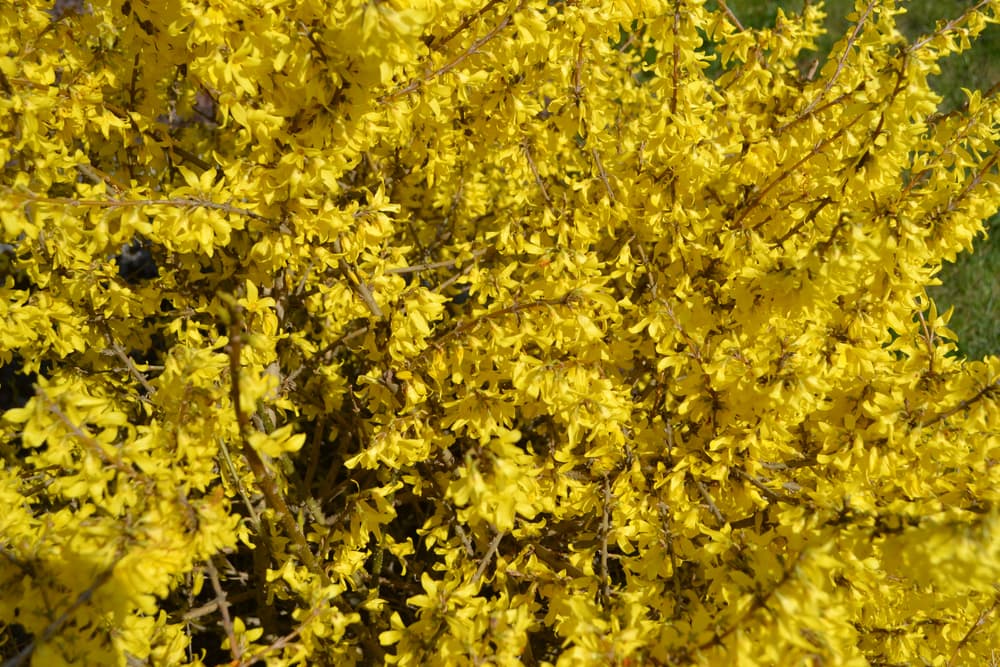
A smaller variety, reaching only 1m in height with a spread up to 1.5m.
The smallish flowers are a pale bright hue of yellow.
It is a profuse bloomer and is noted for being one of the first Forsythia varieties to start blooming, sometimes even from late winter.
It too is a recipient of the RHS’s Award of Garden Merit.
5) F. x intermedia ‘Kolgold’

Another small variety, reaching about 1.5m both in height and spread, seldom reaching 2m.
This relatively new cultivar is a profuse bloomer, producing flowers 2.5-3cm across.
This variety stands out for the deep golden-yellow hue of its flowers.
6) F. x intermedia ‘Goldrausch’
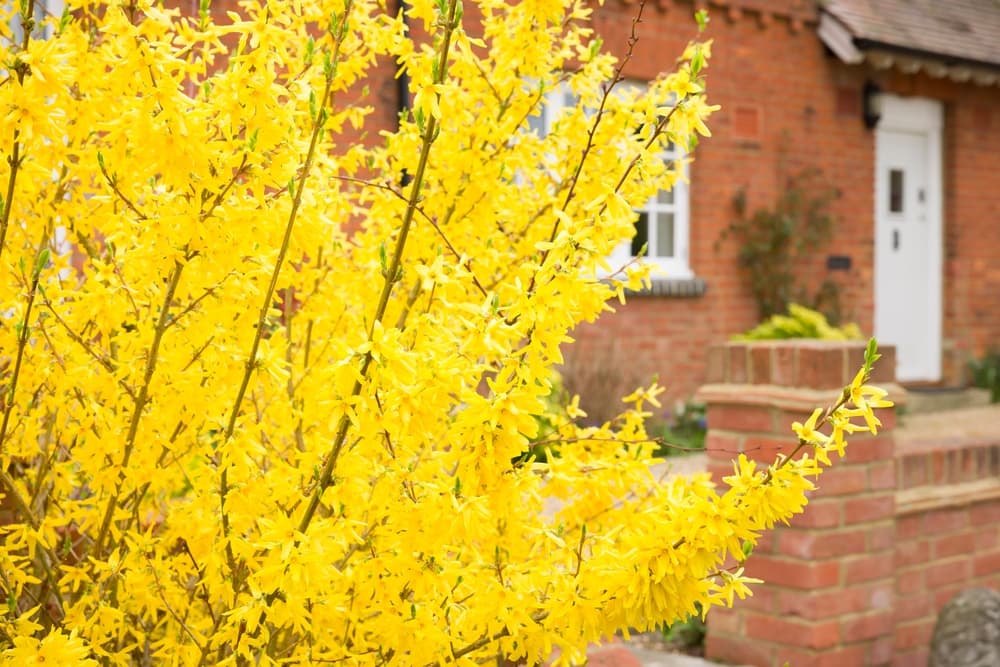
A smallish variety with a height and spread between 1-2m.
Its habit is distinctly fountain-like, so to speak.

This German cultivar is notable for its characteristics of producing blooms on old wood, flowering a little later than most other varieties, and also keeping its flowers a little longer.
It is one of the most reliable and trouble-free varieties.
7) F. koreana

A forsythia with upright shoots that grows to around 2m tall, this option can be semi-evergreen and will frequently retain its leaves through winter after the second year.
As indicated by its name, this is a native of Korea.

Its large flowers are a vivid yellow-golden shade but on this species, the foliage is just as showy.
The leaves are darker than other varieties and are serrated.
Furthermore, they display a striking white ‘latticework’ on their surfaces and they turn purple in early autumn!
8) F. ovata ‘Tetragold’

A cultivar from the Korean species of Forsythia that grows relatively fast but is a small size, topping out at 1.5m in both height and width – and sometimes less.
It has a dense, bushy habit and produces large flowers of a golden-yellow hue.
It is one of the earliest varieties to bloom and its buds are also hardier than other varieties.
9) F. ‘Fiesta’

One of the more spectacular varieties as the foliage nearly steals the show from Forsythia’s celebrated yellow bells.
Another small variety that also reaches a maximum height and width of 1.5m, it has a bushy, mounded shape.
As a smaller and more compact cultivar, it also lends itself to container growing.
The flowers are a deep yellow colour.
The leaves have cream and yellow blotches usually at the centres but sometimes at the edges.
10) F. ‘Show Off Starlet’
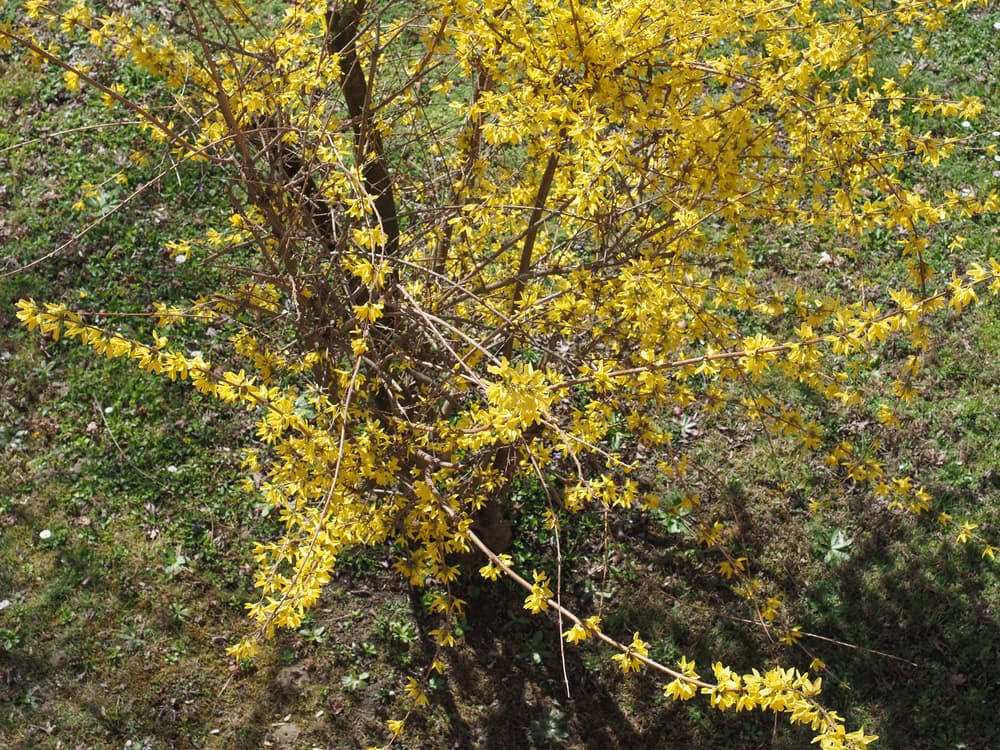
This variety barely reaches 1m in height and spread.
In fact, it is a dwarf variety that is dense and bushy.
It is a relatively recent American cultivar.
The flowers are of a bright yellow hue but it’s their awesome profusion that makes this variety a ‘starlet’ as branches can and do get covered with blooms from end to end.
11) F. suspensa ‘Nymans’

Also a ‘show-off’ but for entirely different reasons.
Large and spreading, this deciduous shrub grows to around 3m in height and width, sometimes even as much as 4m.
Usually 3m and not infrequently 4m tall with a similar width, it’s definitely one of the larger shrubs on this list.
The flowers too are of a stunning size of 4.5cm.

While the foliage is dark, the flowers are unusually gentle in both hue and ‘habit’: they are a soft, pale yellow, and are nodding and pendant.
This variety blooms after virtually all other varieties.
12) F. europaea

One the last species on our list, is also the last Forsythia to start blooming, has a relatively unkempt habit, is probably the least profuse, and certainly has the least showy blooms.
As one may expect, it is not very popular.
Yet it deserves a mention because it is anamolous in every way, including being unique as the only Forsythia species to be native to Europe.
Also, it is becoming quite rare.
13) F. x intermedia ‘Spectabilis’
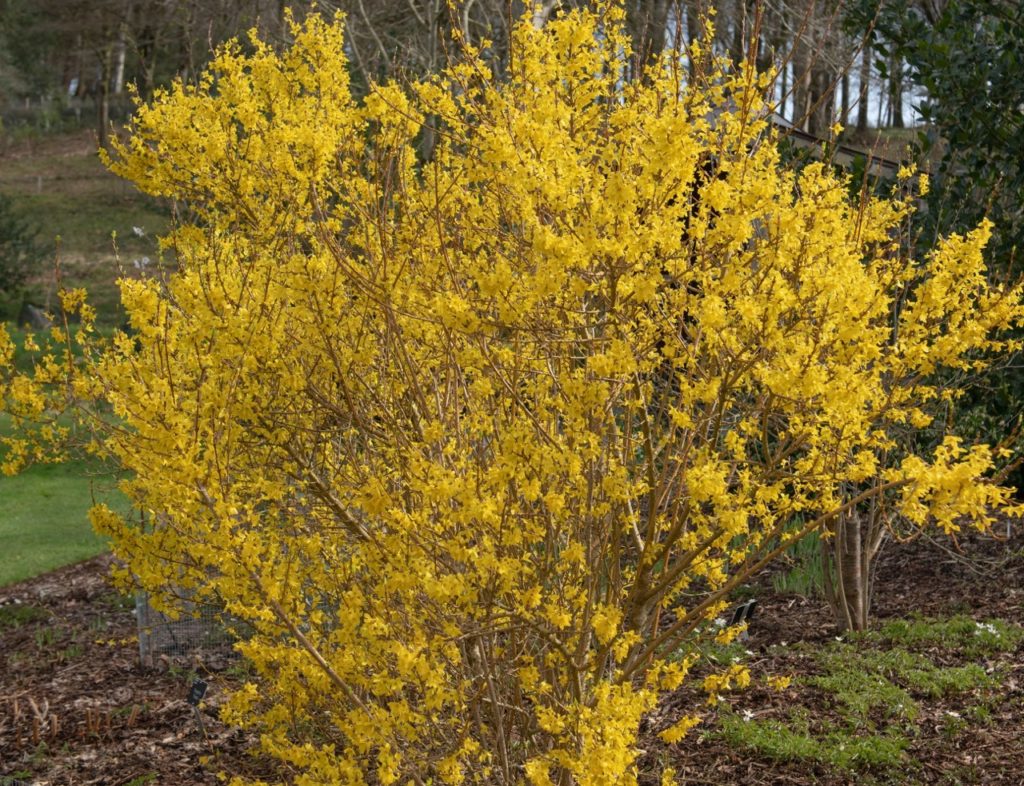
A dramatic shrub that can grow up to 3m tall and 2m wide, this forsythia has elongated, toothed leaves which occasionally have 3 lobes.
In early to mid-spring it bears a profusion of beautiful golden yellow flowers 2-3cm across.
No wonder, then, that this is one of the most popular early-spring flowering shrubs here in the UK.
14) Abeliophyllum distichum

While all forsythias are yellow-flowered, it is worth mentioning this deciduous shrub, which is related to the forsythia and resembles it in a number of ways – except in its flowers which, rather than being yellow, are pale pink to pure white.
These flowers open in late winter or early spring – even earlier than the flowers of true forsythias.
Grow in full sun in well-drained soil, in a sheltered position.
Variety Origins
Forsythia have been cultivated in Chinese gardens for centuries; equally, they are a frequent and important element in Japanese Gardens.
F. suspensa was introduced from Japan to Great Britain in the 1850s by way of the Netherlands.2Johnson, O. (2022). Forsythia suspensa. Trees and Shrubs Online. Retrieved March 16, 2023, from https://treesandshrubsonline.org/articles/forsythia/forsythia-suspensa/
F. suspensa is also called the ‘Weeping Forsythia’ because of the tendency of its branches and boughs to bow and droop, and sough in the wind.

In fact, they are used in European gardens for this very feature where they are trained to ‘weep’ over a boundary wall or a trellis.
The origin of most cultivars is F. x intermedia.
This is a hybrid that was the result of combining the above-mentioned two species over a century ago.
It bears flowers of a rich yellow hue and bears them more profusely than either of the parent species.
This hybrid has an upright habit but with gracefully arching branches.
References
- 1Forsythia viridissima. (n.d.). Kew Royal Botanic Gardens. Retrieved March 16, 2023, from https://powo.science.kew.org/taxon/urn:lsid:ipni.org:names:608903-1
- 2Johnson, O. (2022). Forsythia suspensa. Trees and Shrubs Online. Retrieved March 16, 2023, from https://treesandshrubsonline.org/articles/forsythia/forsythia-suspensa/


